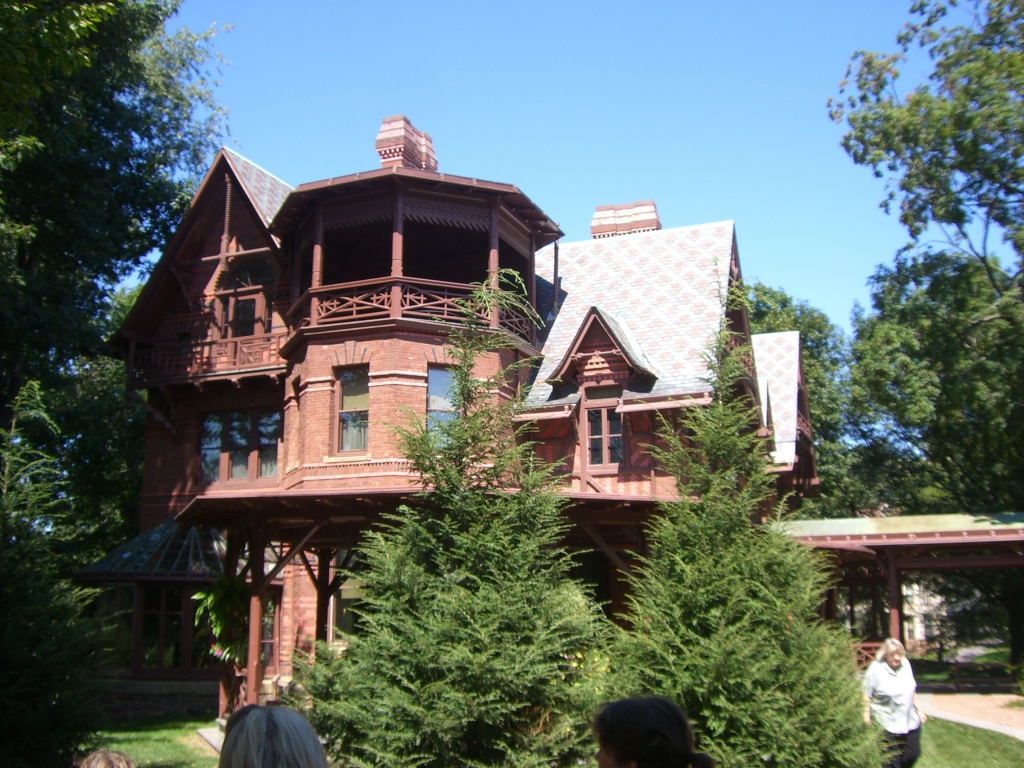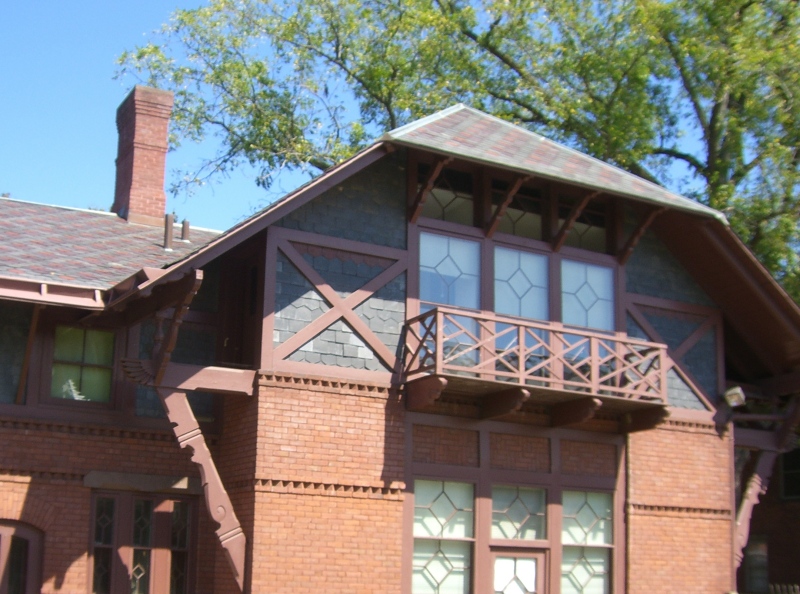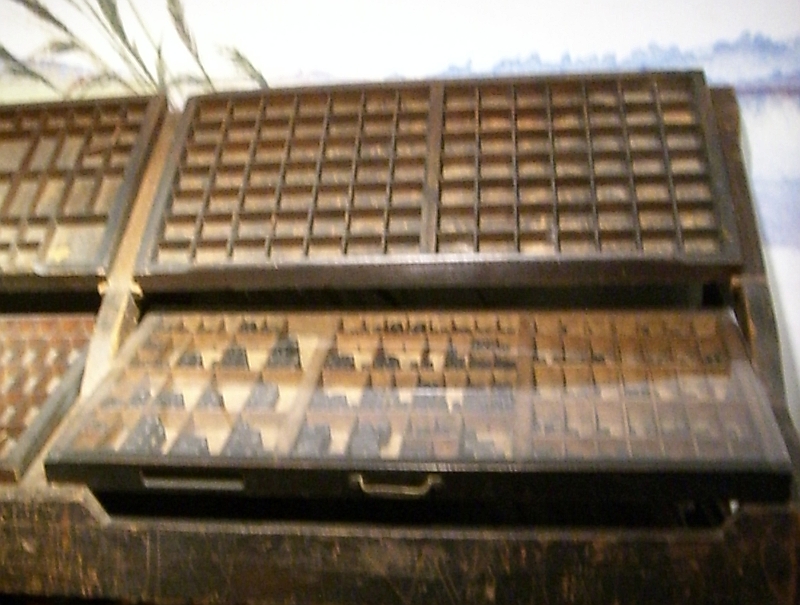Mark Twain House
“Travel is fatal to prejudice” –Mark Twain, Innocents Abroad
 Two week ago on Labor Day we took advantage of the sunny weather and went on our first literary pilgrimage, this time up to Hartford to see the Mark Twain House. This was the house where Samuel L. Clemens and his family lived during eighteen of the most productive years in his career, and where under the pen name of “Mark Twain” he wrote Huck Finn, Connecticut Yankee, and almost all of his other famous works.
Two week ago on Labor Day we took advantage of the sunny weather and went on our first literary pilgrimage, this time up to Hartford to see the Mark Twain House. This was the house where Samuel L. Clemens and his family lived during eighteen of the most productive years in his career, and where under the pen name of “Mark Twain” he wrote Huck Finn, Connecticut Yankee, and almost all of his other famous works.
The House
 The house, which both Twain and his family loved and to which Twain felt a spiritual kinship, has been described as Gothic Revival, but also has some stick work features on its otherwise brick exterior that some say was influenced by the “Victorian Stick Style”, but which make me think more of the criss-cross “Fachwerk” wood patterns on traditional German / Bavarian houses. In any case, the recently restored house was beautiful, and had many touches (including glass and interior work by Tiffany himself) that anticipated the “Arts and Crafts” movement that produced many of the most appealing houses that I have ever entered.
The house, which both Twain and his family loved and to which Twain felt a spiritual kinship, has been described as Gothic Revival, but also has some stick work features on its otherwise brick exterior that some say was influenced by the “Victorian Stick Style”, but which make me think more of the criss-cross “Fachwerk” wood patterns on traditional German / Bavarian houses. In any case, the recently restored house was beautiful, and had many touches (including glass and interior work by Tiffany himself) that anticipated the “Arts and Crafts” movement that produced many of the most appealing houses that I have ever entered.
The house was a gift from Twain’s father in law, who was a wealthy and successful businessman. The same could not be said for Twain himself: few of his business ventures ever paid off. After a particularly poor investment rendered them unable to afford the upkeep on their beloved house they were forced to move to Europe, where they lived for a number of years, and where Mark Twain embarked on a worldwide tour, in hopes of earning enough money to return to the states and the house.
“My axiom is: to succeed in business, avoid my example”
— Mark Twain
Writing Room
Twain wrote late at night in the top floor of the house, which was a low-ceiling room in which there was a pool table and his desk, and where, our tour guide claimed, he would entertain male visitors with cigars and liquor. To highlight this, both the ceiling and the south-facing windows were decorated with pool cues and cigars. The windows were notable for being very thin translucent sheets of rock, etched by the architect with a coat-of-arms of billiard ball-and-cue, as well as the date of construction. Other than the occasional guests, the writing room was off limits to all but the cleaning staff. (Alas, I was not able to get a photo of the translucent windows, as all interior photography was forbidden — but you can see a grainy video capture of the room here).
Technology
 Mark Twain was always fascinated by science and technology (the picture here taken in 1894 in Nicola Tesla’s laboratory), and the house, though constructed in the 1880’s, already had some very advanced gadgets, such as an acoustic intercom (based I believe on the same principle as the tin-can-and-string phone), as well as a bleeding-edge device known as a telephone. The telephone had of course no end of technical problems, and our tour guide produced some interesting sheets of notation that Twain had used each month to complain to the Bell telephone company. One squiggle mark, for example, apparently indicated “the sound of artillery was heard on the line”, while another mark meant that “no combination of switches on the phone would connect us to anybody.”
Mark Twain was always fascinated by science and technology (the picture here taken in 1894 in Nicola Tesla’s laboratory), and the house, though constructed in the 1880’s, already had some very advanced gadgets, such as an acoustic intercom (based I believe on the same principle as the tin-can-and-string phone), as well as a bleeding-edge device known as a telephone. The telephone had of course no end of technical problems, and our tour guide produced some interesting sheets of notation that Twain had used each month to complain to the Bell telephone company. One squiggle mark, for example, apparently indicated “the sound of artillery was heard on the line”, while another mark meant that “no combination of switches on the phone would connect us to anybody.”
The Book Store
The museum book store was filled with books by and about Mark Twain. It is perhaps a testimonial to the interest and popularity of Twain that not only were there dozens of books in the store about Mark Twain, there was even one novel-length book whose title and subject was “How to Write About Mark Twain.” I wondered at the time how that author knew how to go about writing that book, and whether he expected to write yet another book on that topic (and so on…).
How To Tell a Story
I was sufficiently intimidated by the sheer volume of writings by and about Twain that I may well be permanently incapable of bringing myself to the level of arrogance of ego to think I could add anything new to the discussion. If you read more and beyond just the Disney versions of Huck, you begin to see the dark shadows on the edge of the primary colors, and the satirical rage at the follies of the foolish animal called man.
“The humorous story is told gravely; the teller does his best to conceal the fact that he even dimly suspects that there is anything funny about it; but the teller of the comic story tells you beforehand that it is one of the funniest things he has ever heard, then tells it with eager delight, and is the first person to laugh when he gets through. It is a pathetic thing to see[…] To string incongruities and absurdities together in a wandering and sometimes purposeless way, and seem innocently unaware that they are absurdities, is the basis of the American art, if my position is correct.” –Mark Twain, “How to Tell a Story”
 Uppercase and Lowercase
Uppercase and Lowercase
In the museum adjacent to the house was displayed the Pierce automatic typesetting machine which was Twain’s financial downfall. Besides being a riverboat captain on the Mississippi, a prospector in the motherlode country, and an editor, Twain had also been a type-setter. The Pierce machine failed because they were never able to get all the bugs out of it. For comparison there was also on display an old-fashioned typesetting machine, with its trays of letters used to put together a page of a newspaper. As an interesting bit of trivia, the big letters were kept in the upper tray (case), while all the little letters were in the lower case. And hence, so the theory goes, the origin of “uppercase” and “lowercase” letters.
Cats
One surprising feature, ubiquitous in the bookstore, were paintings and pictures of cats. Mark Twain loved cats, which distinguishes him from another of Connecticut’s resident authors, James Thurber. Thurber was a dog man to the core, and had been known to refer to someone in print as “a notorious cat man”. Thurber did not live in Connecticut until long after Twain had died, however, and even then lived nowhere near Hartford, but up in West Cornwall.
But that is another story, and a literary pilgrimage for another day…
“Always obey your parents when they are present.”
— Mark Twain, “Advice to Youth”
